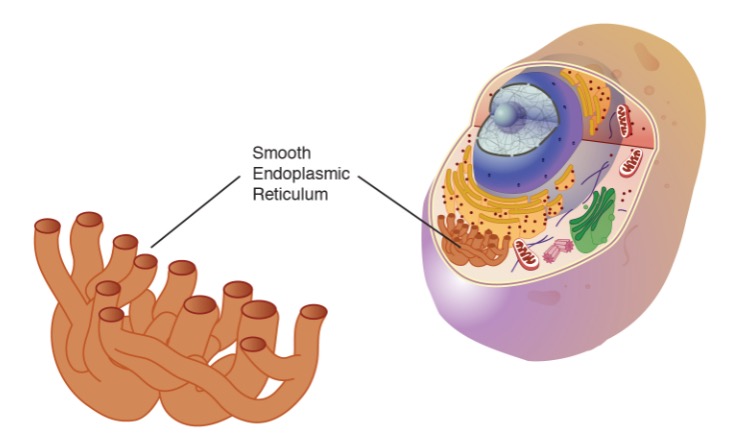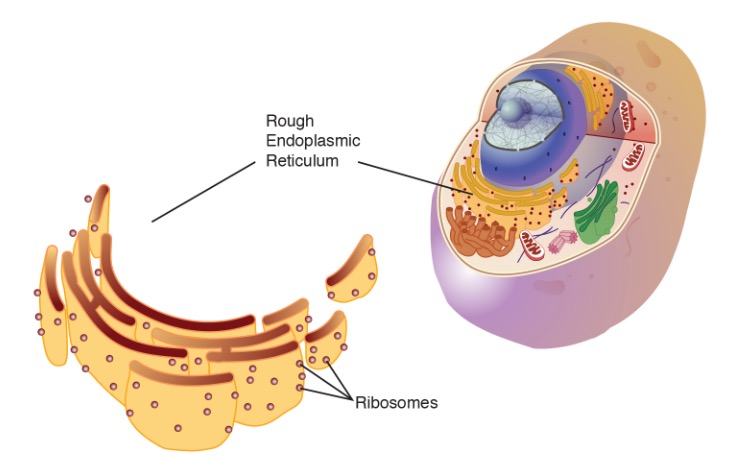Endoplasmic Reticulum (ER) Definition
- The endoplasmic reticulum (ER) is a vast network of membrane-limited channels that is found in the cytoplasm of the majority of animal cells.
- The endoplasmic reticulum is so-called because, under a light microscope, it seems to be a “net in the cytoplasm.”
- Only eukaryotic cells include the endoplasmic reticulum. However, the endoplasmic reticulum can be found in different places in different cells.
- For instance, the endoplasmic reticulum is deficient in erythrocytes (RBC), eggs, and embryonic cells.
- The nuclear envelope and the plasma membrane are somewhat contiguous with the ER membranes.
- Either way, ER is possible. Ribosomes are connected to the outside surface of rough ER, whereas they are not attached to the outer surface of smooth ER.
- The endoplasmic reticulum serves as the cell’s neurological system, circulatory system, secretory system, and storage system. Cellular membrane biogenesis occurs there as well.

Structure of Endoplasmic Reticulum (ER)
- Similar to the unit membrane of the plasma membrane, the endoplasmic reticulum membrane is fluid-mosaic and ranges in thickness from 50 to 60 A^o (50 – 60 nm).
- It has been discovered that several different types of enzymes are present in the endoplasmic reticulum membranes and are necessary for a variety of significant synthetic processes. The stearases, NADH-cytochrome C reductase, NADH diaphorase, glucose-6-phosphatase, and Mg++ activated ATPase were the most significant enzymes.
- The plasma membrane, nuclear membrane, and Golgi apparatus membranes are all still connected via the endoplasmic reticulum membrane.
- The extensively developed cavity of the endoplasmic reticulum acts as a pathway for secretory products.
There are three different types of endoplasmic reticulum:
- Lamellar form or cisternae
- Vesicular form or vesicle and
- Tubular form or tubules
The Cisternae
- RER often manifests as cisternae in cells that have synthetic functions, such as those in the pancreas, notochord, and brain.
- The cisternae are long, flattened, unbranched tubules which look like flattened sacs and have a diameter of 40 to 50 nm.
- They still stay bundled or staked parallel to one another.
The Vesicles
- The oval, membrane-bound vacuolar structures that make up the vesicles range in diameter from 25 to 500 nm.
- They exist in various cells, but are most frequently isolated in the cytoplasm of the SER.
The Tubules
- Like the cisternae and vesicles, the tubules are branching structures that make up the reticular system.
- They typically exist practically everywhere in cells and range in diameter from 50 to 190 nm.
- The tubular form of ER, which is dynamic in nature and frequently observed in SER, is connected to membrane movements, fission, and fusion within the cytocavity network.
You may also like to read: Vacuoles
Types of Endoplasmic Reticulum (ER)

1. Smooth Endoplasmic Reticulum
- The term “agranular endoplasmic reticulum” is also used to describe them.
- The smooth walls of this form of endoplasmic reticulum are a result of the ribosomes’ lack of attachment to the membranes.
- Most of those cells that are engaged in the metabolism of lipids (including steroids) and glycogen include the smooth form of endoplasmic reticulum. For instance, adipose cells, interstitial cells, liver cells that store glycogen, cardiac conduction fibers, spermatocytes, and leucocytes.

2. Rough Endoplasmic Reticulum
- The ribosomes are still anchored to their membranes, which accounts for their rough walls.
- Rough ER (RER) membranes include particular transmembrane glycoproteins for ribosomes, known as ribophorins I and II, to which the ribosomes are linked while undergoing polypeptide synthesis.
- In cells that actively synthesize proteins, such as pancreatic cells, plasma cells, goblet cells, and liver cells, the rough form of endoplasmic reticulum is common.
Endoplasmic Reticulum Functions
- Among the smooth ER’s functions is lipid metabolism (both catabolism and anabolism; they produce various phospholipids, cholesterol, and steroids via synthesis).
- Glycogenolysis (breakdown of glycogen; glycogen getting polymerized in the cytoplasm).
- Withdrawal from medicines (with the assistance of cytochrome P-450).
- The endoplasmic reticulum offers the cell an ultrastructural skeletal skeleton and supports the colloidal cytoplasmic matrix mechanically.
- The endoplasmic reticulum’s membranes allow for the interchange of molecules through the processes of osmosis, diffusion, and active transport.
- The primary part of the endomembrane system, also known as the cytoplasmic vacuolar system or the cytocavity network, is the endoplasmic reticulum.
- Numerous enzymes that carry out numerous metabolic and synthetic processes are found in the endoplasmic membranes. Additionally, the endoplasmic reticulum increases the surface area available for a variety of enzymatic operations.
- The endoplasmic reticulum serves as a transport or circulation system inside the cell.
- A secretory polypeptide that is developing leaves the ribosome, travels through the RER membrane, and builds up in the RER lumen. To create secondary or tertiary protein molecules that are functional, the polypeptide chains go through this process of tailoring, maturation, and molecular folding.
- RER separates out a few small protein-filled vesicles that eventually merge with the cis Golgi.
- It has been discovered that the ER membranes carry intracellular impulses. For instance, in the deep portion of the muscle fibers, the sarcoplasmic reticulum transfers impulses from the surface membrane.
- After each nuclear division, the ER membranes create a new nuclear envelope.
- In addition to being a precursor material for the manufacture of two different types of compounds—the steroid hormones and bile acids—the SER also houses numerous important enzymes that catalyze the creation of cholesterol.
- The rough ER membranes are co-translationally inserted with membrane proteins and glycoproteins that are also produced by RER. As a result, the endoplasmic reticulum is where cellular membranes are made.





